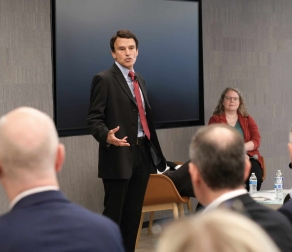For decades, physician researchers and surgical superstars have been advancing medical science at a rapid pace, pushing the boundaries of innovation far beyond what previous generations thought possible. Breakthroughs in the diagnosis and treatment of heart disease, cancer and countless other infirmities have earned American doctors the respect and admiration of patients all over the world.
Today, physicians have more tools and information at their disposal than ever before. They benefit from the availability of sophisticated medications, rapid access to information technology, and cures for diseases that were, once upon a time, automatic killers. Physicians can prevent diseases, avoid complications and save lives with incredible precision and consistency.
With medical innovation and achievement now at an all-time high, you might assume that this would be the Golden Age of physician fulfillment. But you’d be wrong.
Nearly half of American doctors say they experience “burnout” at work. One in five clinicians are clinically depressed. And every year, more than 400 doctors die by suicide. How can this be?
I discussed this bizarre contradiction during my opening keynote address at the 2021 InnovatorMD World Congress, held both online and in-person at the ZGC Innovation Center in Santa Clara, California.
Surveys confirm what is at the root of doctors’ dissatisfaction: a broken healthcare system with its endless paperwork, cumbersome computers and weighty insurance requirements that force doctors to work more and more hours for less and less pay. Four years ago, I wrote a bestselling book about these systemic obstacles to better care. “Mistreated: Why We Think We’re Getting Good Healthcare—and Why We’re Usually Wrong” included a roadmap for the future of medicine in which doctors lead the transformation toward integrated, prepaid and technologically advanced healthcare—the kind of high-quality, low-cost care that puts patients first and restores the true mission of medicine for doctors.
Four years later, little has changed. In fact, the latest Commonwealth Fund report confirms, once again, that the United States has the most expensive and least effective healthcare in the developed world. Americans have the lowest longevity, and highest rates of childhood mortality and maternal death, among the 11 high-income nations included in the report.
If we know the problem but can’t fix it, perhaps there is something else—something other than a broken system—that needs fixing. After interviewing hundreds of doctors and digging through mounds of research on the causes of physician burnout and poor patient health, I came to recognize the existence of an unseen force that contributes to the sad state of healthcare today. That force is physician culture, which is the subject of my newest book “Uncaring: How the Culture of Medicine Kills Doctors & Patients” (all profits go to Doctors Without Borders).
Medical culture is both invisible and highly influential—made up of the values, norms and beliefs that doctors acquire in medical school and carry with them throughout their careers. It has the power to bring about great acts of heroism in doctors, who are willing to risk their lives to save patients. But it can also obscure the doctor’s perception of reality, causing them to act in ways that appear self-serving and callous to outsiders. It is my hope that our nation will acknowledge the obstructive roles of both the healthcare system and the culture of medicine, and that doctors will be the ones who decide to improve them both.
At the very start of the InnovatorMD World Congress, the organization’s founder and president Uli K. Chettipally shared his vision to spread physician innovation all over the world in ways that improve patient outcomes and physician wellness. I share Uli’s vision and belief that doctors can—and must—lead the way.
I want to thank the hundreds of people who attended the conference. Your questions were fabulous and, unfortunately, there was not enough time to address all of them. So, I will the take this opportunity now to answer a few more:
Q1. Technology is accelerating change in all aspects of life. Any idea of time frame when medical industry would fully embrace it? (Ravi M.)
It’s impossible to give a timeframe because the clock hasn’t started ticking yet. Clinicians have for centuries rejected innovations that threaten their exceptionalism. In the 1700s, they said no to Daniel Fahrenheit’s thermometer, a device that can measure a patient’s internal temperature more accurately than a physician ever could. It took more than a century and a half for that innovation to take hold. Even today, doctors remain threatened by innovations that challenge their relative status and expertise, from artificial intelligence to data analytics. To remove the threat, we must alter the incentives. We must do away with fee-for-service payments that encourage doctors to do more and embrace capitated payments that incentivize doctors to do better.
Q2. What are ways we call out the negative medical culture to our peers – or how do you suggest making this blind spot more noticeable to our field so we can attempt to embrace these accelerating technological improvements? (Will C.)
What’s “normal” inside physician culture can seem very odd to those outside the profession. As doctors, we are so deeply embedded in our day-to-day norms that we often don’t notice the peculiarities of our language, rituals and customs. That’s why I often urge colleagues to take a step back and ask themselves a simple, disarming question: “Did I treat all of my patients today as I would have treated a parent or sibling?” I am certain that if every physician asked this question of themselves and of their colleagues, we would provide more compassionate care that is higher quality and lower cost than we do today.
Q3. Do you think there is anything we as innovators can do to encourage acceptance of impactful innovations in the medical field, so they are implemented much quicker than in 17 years? (Martina T.)
Doctors don’t dislike technology. They simply wish that technology could make their lives—and the lives of their patients—better. Consider the prevalence of monitoring tools that send hundreds of test results or heart tracings to the doctor. No physician wants all that data. What they want and would embrace is a tool that reassures them when their patients are following recommended treatments and getting better. Rather than inventing tech and then finding a use for it, innovators should ask: “What is the problem I’m trying to solve?” That answer should guide the innovation process.
Q4. What’s your take on direct primary care or direct care models? (Sharon N.)
The primary care model in the U.S. is broken. It undervalues the excellence of care those doctors provide. Research demonstrates that adding 10 primary care physicians to a community increases longevity by 250% over 10 added specialists. And yet we elevate the status of interventionalist while failing to reward the physicians who keep patients healthy and prevent medical problems from happening in the first place. The solution is prepaid, integrated healthcare that respects the important work of prevention and chronic disease management.
# # #
Dr. Robert Pearl is the former CEO of The Permanente Medical Group, the nation’s largest physician group. He’s a Forbes contributor, bestselling author, Stanford University professor, and host of two healthcare podcasts. Pearl’s next book, “Uncaring: How the Culture of Medicine Kills Doctors & Patients” is available now. Follow him on Twitter @RobertPearlMD. Learn more at RobertPearlMD.com.









[…] have the chance to hitch collectively in risk-based teams that settle for prospective payments—a lump sum for all of the care offered to a inhabitants of sufferers in a given yr. Although docs […]